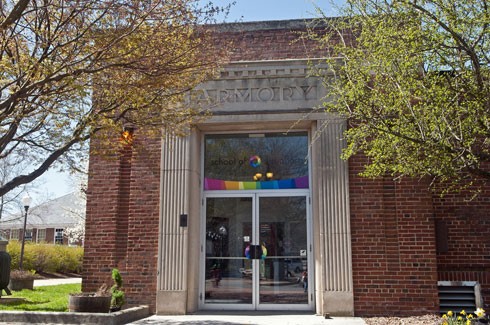Old Armory/Armory Gallery of Art
Introduction
Text-to-speech Audio
Images
The armory building was constructed in 1936 with funding from the federal government and funding from the city. The building served as both an armory and a municipal building until acquired by the university.

Backstory and Context
Text-to-speech Audio
The site of the Armory was once the location of the Blackburg Public Schools. The Works Progress Administration (WPA) constructed the building as a National Guard Armory in 1936. A historical marker resides at the site.
The second Blacksburg High School, built in 1916, stands behind the armory, and after the passing of the building's use for military training, used the armory as an auditorium. Until the 1960s it was the location of school and community events as varied as a speech clinic run by the Blacksburg Elementary School and performance by Grand Ole Opry singer Margaret Carson in the 1950s. Virginia Polytechnic Institute (the name of Virginia Tech from 1944 to 1970) and the town of Blacksburg jointly owned the building for a time around the 1960s.
The School of Visual Arts at Virginia Tech maintains offices and gallery space in the Armory. As part of the Arts Initiative, Virginia Tech renovated the space in 2007. The building's large mezzanine provides a setting for many art exhibitions while the rest of the building serves as secondary galleries, workspaces, and classrooms. The museum also offers a variety of exhibits drawn from the work of regional artisans, displays of faculty and student work, and exhibits of regional artists that were created as part of the university's Summer Arts Festival. The Armory Art Gallery is free and open to the public.
Sources
Strother, Warren H.. Wallenstein, Peter. From VPI to State University: President T. Marshall Hahn, Jr. and the Transformation of Virginia Tech, 1962-1974. Macon, GA. Mercer University Press, 2004.
Elliott, Jean. Arts transformation continues at Virginia Tech, Virginia Tech Daily. April 1st 2008. Accessed October 27th 2019. https://vtnews.vt.edu/articles/2008/04/2008-218.html.
Miller, Dwight Earl. An Elementary School for Blacksburg. Blacksburg, VA. Virginia Polytechnic Institute Department of Architecture, 1958. Accessed October 27th 2019. https://vtechworks.lib.vt.edu/bitstream/handle/10919/74064/LD5655.V853_1958.M555.pdf?sequence=1
